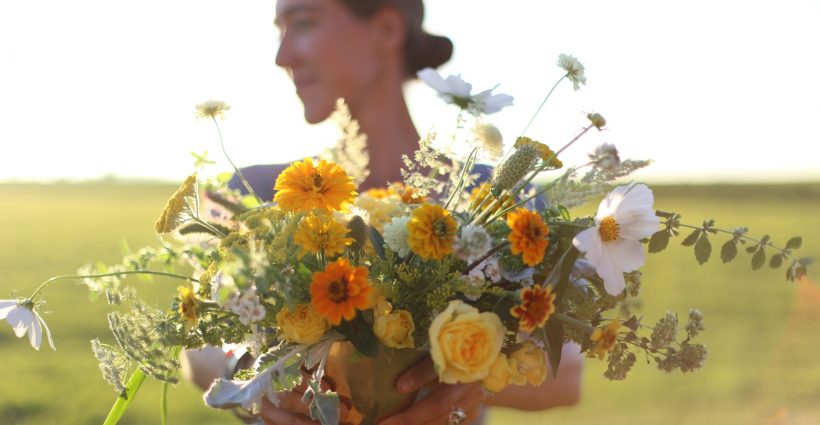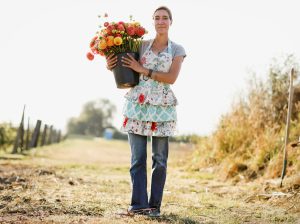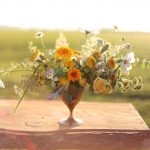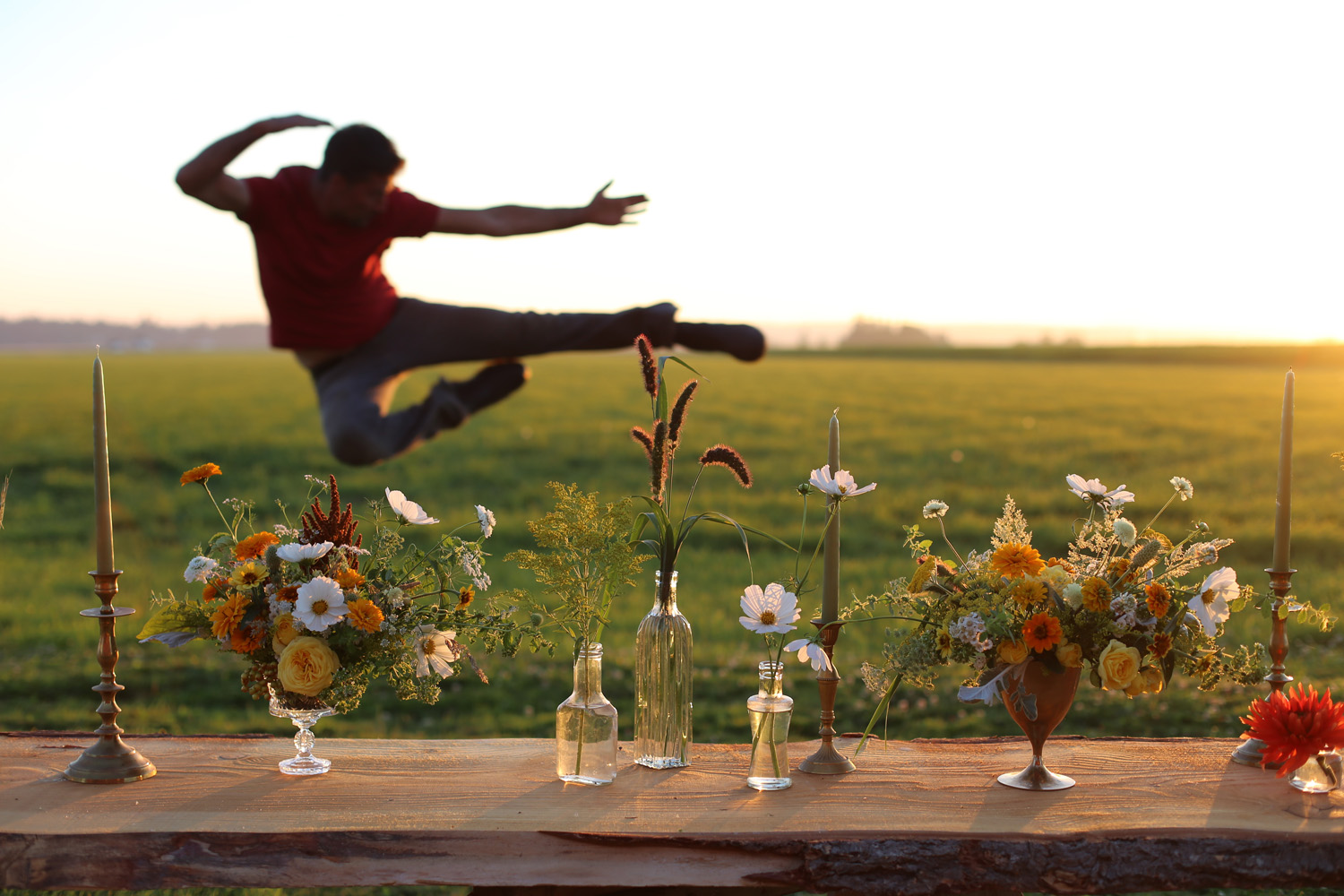designed for the way women work.

Floret Founder Shares Flower Arranging Secrets
Category: How-To Projects, Presenting "The Curious Gardener"

Erin Benzakein, founder of Floret, is one of the original farmer-florists. On her farm in Washington’s Skagit Valley, she and her family have created a thriving flower farm, design studio and learning center. Her workshops are soldout affairs, created for those who want to learn more about small scale, high intensity flower production and floral design.

We asked Erin to share some of her secrets to creating beautiful flower arrangements. Here’s what she wrote:
Harvesting tips:
 Harvest in the coolest parts of the day. Early morning or in the evening are the best times to cut your flowers, as blooms harvested during the mid-day heat tend to wilt faster.
Harvest in the coolest parts of the day. Early morning or in the evening are the best times to cut your flowers, as blooms harvested during the mid-day heat tend to wilt faster.
Use clean, sharp clippers. Rusty, dull flower snips are not only frustrating to use, they can damage your stems. Cut stems at 45 degree angles.
Allow flowers time to “rest” prior to arranging them. This process is called conditioning and it is a key step that is often overlooked. Place freshly harvested flowers into water for a few hours to allow the uptake of water into the stems. You’ll be amazed at how some semi-wilty flowers will perk up after being conditioned for a few hours.
Remove bottom leaves from stems. Leaves that have been left on the stem and then submerged in water will quickly start to decay.
Always utilize clean vases. Dirt and bacteria can cause your flowers to wilt prematurely, so be sure to wash vases thoroughly with hot soapy water prior to putting fresh cut flowers into them. Add water and commercial flower food, if you have it.
Choose short- or medium- sized vases. Whether it is for an elegant wedding or a simple centerpiece for my dining room table, I prefer to use shorter vases that have wide openings. While mason jars and common clear glass cylinders are fine for a big bunch of a single type of flower, the flowers only have one way to go: up. Vases with wide openings, such as a footed compote, allow for a wider, more interesting bouquet shape that stretches out horizontally, allowing for an unimpeded view across the table.
Add stem support. With most vases, particularly wide-mouthed vessels, you will need some sort of structure to support the flower stems. My preferred technique is to utilize coated chicken wire. If you ball up a piece inside the vessel, the wire provides multiple places for the stems to “catch” on the wire and form the bouquet’s shape. This technique creates a more natural look to your design than floral foam. (Foam makes bouquets look “stiff;” plus it is not eco-friendly). If you don’t have chicken wire, try using waterproof floral tape to create a grid over the opening of the vase to provide support for the stems.
Create your foliage framework. To start, choose foliage with sturdy, slightly arching stems in order to create the overall bouquet shape. Then begin layering in supporting greens and vines, echoing the original shape you established. Mint, ninebark, eucalyptus and raspberry greens are a few of my favorite foliages from the garden. Great options for supporting greens and vines include: love in a puff vine, sweet pea vines and foliage, scented geranium, cup and saucer vine, akebia vine and ‘sweet autumn’ clematis.
Thread in color & texture: Now it’s time to start adding in the flowers. Be sure to give the flowers “room to breathe.” In other words, do not try to cram a bunch of flowers into a tight, flat, dense cluster. The bouquet should have a lighter, airy feel to it.
Flower types to incorporate:
- Focal: These large blooms are usually the stars of the show. Some of my favorites focal flowers are peonies, garden roses and dahlias.
- Filler: These smaller flowers, like cosmos or clustered blooms such matricaria ‘vegmo single,’ are great complements to the focal flowers.
- Textural elements: Incorporate uncommon ingredients such as poppy pods, crabapples or blackberries to add visual interest and texture.
 Finish with airy accents: Add in some delicate accents, such as grasses, or any frilly or umbel-shaped flowers. These elements should occupy a separate “plane” of the bouquet, which may be slightly higher or extended outward just beyond the larger flowers that form the shape of the bouquet. Some of my favorite flowers and grasses to use for airy accents include: chocolate laceflower (daucus carota), False Queen Anne’s Lace (ammi majus), and fiber optic grass ‘frosted explosion’ (panicum elegans).
Finish with airy accents: Add in some delicate accents, such as grasses, or any frilly or umbel-shaped flowers. These elements should occupy a separate “plane” of the bouquet, which may be slightly higher or extended outward just beyond the larger flowers that form the shape of the bouquet. Some of my favorite flowers and grasses to use for airy accents include: chocolate laceflower (daucus carota), False Queen Anne’s Lace (ammi majus), and fiber optic grass ‘frosted explosion’ (panicum elegans).
Enjoy your flowers!
Flowers featured in the photos include: False Queen Anne’s lace, cosmos, Persian Carpet zinnias, scabiosa, garden roses, helianthus, lemon verbena, crabapples, oregano flowers and dock.
 We are inspired by Erin’s story and we created hang tags for our garden gloves so all of our customers can read about Erin and the farmer-florist movement.
We are inspired by Erin’s story and we created hang tags for our garden gloves so all of our customers can read about Erin and the farmer-florist movement.







Just the best! Thank you!!
TY for the wonderful tips and for brightening our lives! 🙂
The fan-shaped spread of your flowers is lovely; the anchor is clearly key. Especially charming is your unconventional choice of flowers, which work beautifully together. Thank you!
Please enter me for the giveaway. I love to arrange cut flowers and always have flowers in at least one vase in my home.
Thank you.
Beautiful
Sure hope I am a lucky winner.